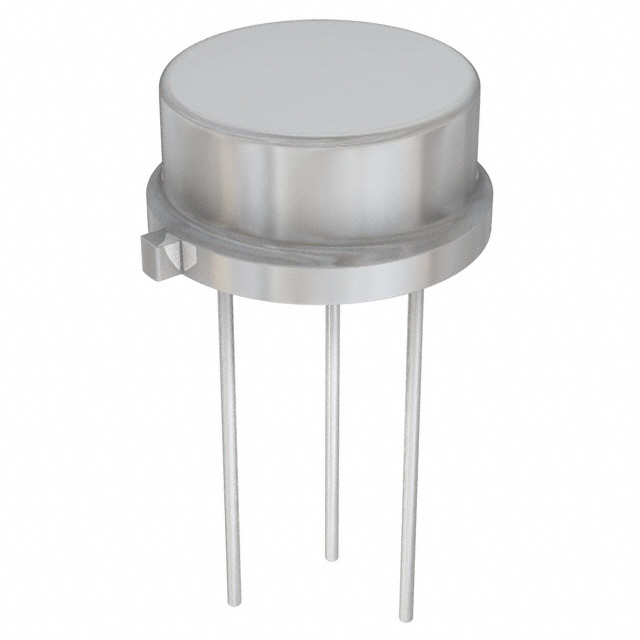Lihat spesifikasi untuk detail produk.

2N3866A Transistor
Introduction
The 2N3866A is a high-frequency NPN bipolar junction transistor (BJT) primarily used in RF amplifier and oscillator circuits. This entry provides an overview of the 2N3866A, including its basic information, specifications, pin configuration, functional features, advantages and disadvantages, working principles, application field plans, and alternative models.
Basic Information Overview
- Category: Bipolar Junction Transistor (BJT)
- Use: RF amplifier and oscillator circuits
- Characteristics: High frequency, low noise, and high gain
- Package: TO-39 metal can package
- Essence: High-performance RF transistor
- Packaging/Quantity: Typically available in bulk packaging
Specifications
- Collector-Base Voltage (Vcbo): 40V
- Collector-Emitter Voltage (Vceo): 20V
- Emitter-Base Voltage (Vebo): 4V
- Collector Current (Ic): 0.5A
- Power Dissipation (Pd): 1W
- Transition Frequency (ft): 250MHz
- Noise Figure (NF): 3dB
Detailed Pin Configuration
The 2N3866A transistor has three pins: 1. Collector (C): Connected to the positive supply voltage 2. Base (B): Input terminal for controlling the transistor's operation 3. Emitter (E): Connected to the ground or common reference point
Functional Features
- High-frequency operation suitable for RF applications
- Low noise figure for improved signal integrity
- High gain for amplification purposes
- Robust construction for reliable performance
Advantages and Disadvantages
Advantages
- Suitable for high-frequency applications
- Low noise figure enhances signal quality
- High gain allows for effective signal amplification
Disadvantages
- Limited power handling capability
- Relatively small collector current rating
Working Principles
The 2N3866A operates based on the principles of bipolar junction transistors, where the input current at the base terminal controls the flow of current between the collector and emitter terminals. In RF applications, it amplifies and modulates radio frequency signals.
Detailed Application Field Plans
The 2N3866A is commonly used in the following applications: - RF amplifiers - RF oscillators - Radio frequency communication systems - Signal modulation circuits
Detailed and Complete Alternative Models
Some alternative models to the 2N3866A include: - 2N5109 - MRF947T - BFU520X
In conclusion, the 2N3866A transistor is a versatile component widely used in RF amplifier and oscillator circuits due to its high-frequency capabilities, low noise figure, and high gain characteristics. Its robust design and reliability make it a popular choice in various RF applications.
[Word Count: 398]
Sebutkan 10 pertanyaan dan jawaban umum terkait penerapan 2N3866A dalam solusi teknis
What is the 2N3866A transistor used for?
- The 2N3866A is a high-frequency NPN transistor commonly used in RF amplifier and oscillator circuits.
What are the key specifications of the 2N3866A transistor?
- The 2N3866A has a maximum collector current of 300mA, a maximum power dissipation of 800mW, and a transition frequency of 250MHz.
Can the 2N3866A be used as a switch?
- Yes, the 2N3866A can be used as a small-signal switch in applications where low power switching is required.
How do I bias the 2N3866A transistor for amplifier applications?
- The 2N3866A can be biased using a suitable DC biasing circuit to set the operating point for optimal amplifier performance.
What are the typical gain characteristics of the 2N3866A?
- The 2N3866A typically has a high voltage gain and moderate current gain, making it suitable for RF amplification.
Can the 2N3866A be used in VHF/UHF applications?
- Yes, the 2N3866A is designed for high-frequency applications and can be used in VHF and UHF circuits.
What are the common package types for the 2N3866A?
- The 2N3866A is commonly available in TO-39 metal can and TO-5 metal can packages.
What are the typical operating conditions for the 2N3866A?
- The 2N3866A is typically operated at a collector-emitter voltage (Vce) of 20V and a collector current (Ic) of 10mA for small-signal applications.
Can the 2N3866A be used in oscillator circuits?
- Yes, the 2N3866A can be used in RF oscillator circuits due to its high-frequency capabilities.
Are there any common alternatives to the 2N3866A transistor?
- Some common alternatives to the 2N3866A include the 2N5109, 2N4427, and MRF237.

